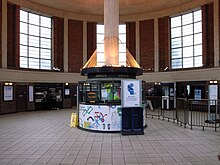Arnos Grove Underground Station
Arnos Grove is an above-ground London Underground station in the London Borough of Enfield . It is in the Travelcard tariff zone 4 on Bowes Road. In 2013, 4.48 million passengers used this station served by the Piccadilly Line .
history
The station opened on September 19, 1932, when the Piccadilly Line was extended here from Finsbury Park . Until the extension to Cockfosters was commissioned on March 13, 1933, Arnos Grove was the northern terminus for half a year. The choice of the station name was made after a public hearing; Arnos Park , Bowes Road and Southgate were also discussed as alternative names . Due to the terrorist attacks of July 7, 2005 , only the section north of Arnos Grove could be used for a few weeks; on August 4th, the central section to Hyde Park Corner was reopened .
investment
Some trains do not run to the Cockfosters terminus , but already turn around in Arnos Grove. This happens especially during rush hour and in the evening, but also in the event of technical disruptions. For this reason, the station has two central platforms with three tracks, with the middle track being used for turning trains. South of the station is a parking facility with seven tracks.
Like the rest of the stations that Charles Holden designed for this section of the route, Arnos Grove was built on the basis of geometric shapes in the modernist style, using bricks, glass and reinforced concrete. A round, drum-like hall with tall windows and a flat concrete roof towers over a single-storey square building. Holden was inspired by the Stockholm City Library and the Swedish architect Gunnar Asplund . In the middle of the cylindrical entrance hall is one of the former control houses, which today houses a small exhibition about the history of the station and the Piccadilly Line.
The architecture critic Jonathan Glancey described Arnos Grove as "... truly what German art historians as a total work of art would call, a total and comprehensive work of art" (... truly what German art historians would describe as a Gesamtkunstwerk, a total and Entire work of art) . The building has been a listed building since 1971. At first it had the protection level Grade II , in 2011 this was increased to Grade II * due to the outstanding architectural importance.
In 2005 the station was completely renovated as part of an investment program by Transport for London. The main focus of the work was the restoration and restoration of the original condition of the listed building. In addition, the underground station was equipped with modern technology, including video surveillance, information pillars and digital train destination displays.
To the south of the station there is a parking facility with seven tracks.
Web links
- Photo of the station building (1932). Archived from the original ; accessed on September 3, 2018 .
- Historical photos of the station building and the platforms. Retrieved September 3, 2018 .
Individual evidence
- ↑ 2013 annual entries and exits. (Excel, 228 kB) Transport for London, 2014, accessed on July 27, 2014 (English).
- ↑ a b Piccadilly Line. Clive's Underground Line Guides, accessed January 26, 2013 .
- ↑ Alan Dumayne: Southgate . Sutton Publishing Ltd., Stroud 1998, ISBN 0-7509-2000-9 , pp. 44 .
- ^ A b Jonathan Glancey: Going underground. The Guardian , October 16, 2007, accessed January 26, 2013 .
- ↑ Arnos Grove Underground station. In: National heritage list of England. National Heritage, accessed January 26, 2013 .
- ^ Arnos Grove improved , Transport for London. February 25, 2005. Archived from the original on May 10, 2015. Retrieved May 10, 2015.
| Previous station | Transport for London | Next station |
|---|---|---|
| Bounds Green |
|
Southgate |
Coordinates: 51 ° 36 '59 " N , 0 ° 7' 59.1" W.


